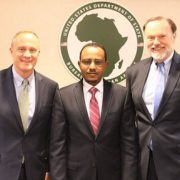Lawrence Freeman
In the last decade, Ethiopia, the
second most populated nation in Africa with over 100 million people, has become
a leader in economic growth. This is the result of the leadership’s commitment
to the continuation of the previous government’s developmental state model,
which directed public credit to finance vital infrastructure projects. Now,
under new leadership, innovative initiatives are being launched to sustain and
expand Ethiopia’s progress.
On September 9, 2019, Prime
Minister Abiy Ahmed unveiled his nation’s “Homegrown
Economic Reform Agenda” (Homegrown Reform) at the
United Nations Conference Center in Addis Ababa. Its primary goal is to expand
the nation’s economic capabilities, and create employment opportunities for
millions of unemployed youth. Addressing the audience, Prime Minister Abiy
said: “The Reform Agenda is
our pro-job, pro-growth, and pro-inclusivity pathway to prosperity.” To achieve
these objectives, this new initiative proposes to entice private investment in
the following sectors; agriculture, manufacturing, mining, tourism, and
Information and Communication Technology- (ICT). Key goals of the agenda’s
macroeconomic reforms are, curbing inflation that is averaging over 15% in the
last four years, increasing foreign currency, improving access to finance, and
debt sustainability.
Home Grown Initiative
The Homegrown
Reform Agenda is not meant to be a replacement for Ethiopia’s
Growth Transformation Plans II (GTP II), which covers the period, from
2014-2019.
Ethiopia, aims over the next three years, to attract $6 billion
in new soft loans and $4 billion in debt reduction from multilateral and
bilateral institutions to alleviate the country’s financial constraints.
According Fitsum Arega, Ethiopia’s ambassador to the United States, “many
industries are operating below capacity for lack of foreign currency to pay for
imports.”
For Ethiopia to advance to the next
stage of development certain imbalances and bottlenecks in the economy have to
be corrected, which the Homegrown
Agenda intends to accomplish through macro and fiscal
reforms. The number one constraint to growth cited by manufacturing
firms, is the shortage of foreign exchange. Access to financing, inefficiency
in government, and insufficient infrastructure are also leading constraints to
doing business in Ethiopia. In an effort to address these limitations,
the Homegrown Reform intends
to shift from relying exclusively on public sector investment, which has led to
a rise in Ethiopia’s debt, to promoting private sector financing.
Another area of concern for the government is relying on
inefficient state-owned firms. A case in point is the military-run industrial
conglomerate METEC, which is being investigated for corruption and suspicion of
misappropriating public funds.
To complement the new reforms, it is recommended that the
government make additional efforts to; discipline public expenditures, attract
remittances through legal channels, and end contraband.
Ethiopia On The Road of Progress
The following indicators of
economic growth are reported in A Homegrown Reform Agenda: Pathway to Prosperity power-point.
From 2004 to 2015, Ethiopia succeeded in reducing the percentage of people
living in poverty-$1.90 per day or less- from 39% to 24%. From 2004 to 2018 per
capita income grew from $200 per day to over $800. During that same time frame,
child mortality (under age 5) decreased from 123 to 55 per 1000 live births,
and life expectancy increased from 56 years to 66. And from 2005 to 2016
the percentage of the population with access to electricity rose from 14% to
43%–a 300% increase.
Ethiopia aspires to reach the
status of a “lower middle income” nation by 2025. This is an ambitious goal
that will require; raising yearly per capita income from its levels of $856 to
$2,219, reducing poverty from 27.3 % of the population to 13.8%, and increasing
access to electricity to 86% of its citizens. For Ethiopia to achieve its
objective in the next five years, it needs to mechanize its agriculture sector
to be more productive and less labor intensive, and increase manufactured
exports five-fold.
Ethiopia’s Job Offensive
Simultaneously, Ethiopia’s
leadership is tackling the critical issue of unemployment, especially for the
growing number of college educated youth, who are seeking jobs and upward
mobility. Ethiopia’s Jobs Creation
Commission-(JCC) announced on October 30, a bold plan to create 14
million jobs by 2025, and a total of 20 million new jobs by 2030. This will
provide employment opportunities for millions of new entrants into their labor
force. The government intends to create 3 million jobs in the budget year that
began this July.
In partnership with the JCC, Mastercard Foundation presented
its Young Africa Works
Initiative–committing $300 million to assist in this job creation
program. Their focus will be generating new employment opportunities in
the ICT and Small Medium Enterprises-(SME) sectors. According to the JCC
website: “The Young Africa
Works in Ethiopia is an initiative that will enable 10 million
young people to access dignified and fulfilling work by 2030…It was designed in
partnership with the government, the private sector, academic institutions, and
young people and; is currently aligned with the Ethiopian government’s plan to
create new jobs to spur economic growth.”
Economics and the Nation State
Ethiopia’s economy has been
growing at a faster rate than other sub-Saharan nations. However, its prolific
university system is graduating more young people than Ethiopia’s economy can
employ. Simply put: despite the progress that Ethiopia has accomplished in
reducing poverty and building physical infrastructure; the economy is not
growing at a level fast enough to accommodate its large and expanding
population.
Frustration over the slower than
desired rate of development is being expressed by various elements of society.
Economic well-being is a substantial motivation that underlies the anger by ethnic
movements at those in power. Ethnic groups believe it is necessary to have
“their leaders” in charge, in order to ensure a bigger slice of the “economic
pie.” People, who judge that they are being economically neglected or
marginalized can become desperate, and thus susceptible to being manipulated
and aroused to take action against their own government.
To avoid such instigated
conflicts, the only real and lasting solution is to create a “bigger economic
pie” that equally satisfies the needs of all people regardless of geographical
region or ethnicity. It is the unique responsibility, nay obligation, of the
nation state to provide for the “general welfare” of its people and their
posterity, as beautifully articulated in the preamble to the US Constitution.
The nation state transcends (not negates) regionalism, ethnicity, and religion.
Its primary concern is the continued existence of a single sovereign Ethiopian
nation with one integrated and unified people.
The government is responsible for
ensuring that every Ethiopian has the necessities of food and shelter, and
the opportunity for a meaningful life for oneself and one’s progeny.
Deliberating on the best pathway to achieve these goals is the responsibility
of every citizen. It is in the self interest of all Ethiopians to collaborate
in securing a prosperous future for their nation.
Lawrence Freeman is a
Political-Economic Analyst for Africa with thirty years of experience in Africa
promoting infrastructure development policies.










